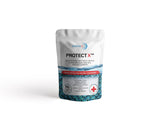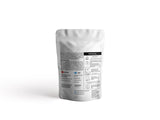Chloramine-T is employed as an essential and reliable disinfectant for fish for many years with its good efficacy and low toxicity to fish, shrimp and aquatic environments. Chloramine-T is used in salt, brackish and fresh water environments.
All-round disinfectant
Disinfection of tanks and ponds, nets, equipment. Chloramine-T ensures that pathogenic microorganisms are rapidly and effectively destroyed.
Safe in use
As with any biocide protection measures are required, but can be handled by using standard personal equipment. Chloramine-T is the safe alternative for traditional and more dangerous chemicals. It is nontoxic for fish and shrimp at effective dosage and does not leave residues in the animals.
Safe for the environment
With its readily biodegradable action, is the safe alternative for dangerous chemicals does not accumulate in river beds and is not toxic to the aquatic environment.
Efficiency
Chloramine-T is effective against many microorganisms related to aquaculture applications. A few of them are indicated below, but the complete activity spectrum of Chloramine-T is much wider.
Bacteria
Aeromonas salmonicida (Furunculosis) / Flexibacter maritimus (Marine columnaris) / Flavobacterium branchiophilum (BGD) / Flavobacterium columnaris (Columnaris) / Vibrio anguillarum (Vibriosis) / Vibrio harveyi
Viruses
Hemorrhagic septicemia virus
Fungi
Saprolegnia
Parasites
Gyrodactylus salaris / Ichthyobodo necator (Costia) / Ichthyophthirius multifilis (White spot) / Neoparamoeba pemaquidensis (Amoebic Gill Disease) / Trematodes
DOSE GUIDE
 WARNING: This step is very important, you need to know the pH and GH of your water to determine the safe dose level. Using a high dose than what is allowed based on your pH/GH level may cause serious damage or death to the fish. If in doubt or on the boarder go for the lower concentration
WARNING: This step is very important, you need to know the pH and GH of your water to determine the safe dose level. Using a high dose than what is allowed based on your pH/GH level may cause serious damage or death to the fish. If in doubt or on the boarder go for the lower concentration
TREATMENT PROCEDURE:
DISCUS AND KOI SHORT BATH
First step prepare dilute Chloramine-T stock solution by dissolving 4 level spoons (included) or 2g of Chloramine-T powder in one liter of water mix well until completely dissolved. Place the fish in a tub with clean water (with no chlorine or chloramine and without any chlorine removal chemicals) add an air stone for aeration. Add 1ml of Chloramine-T stock solution to each liter of the water bath to produce 2 mg/L concentration.
Keep the fish in the bath for a maximum of 5 hours, keep an eye on the fish during this period. If you notice signs the fish can’t tolerate the bath anymore, remove it to it’s aquarium. This bath can be repeated daily up to 5 days.
Use this equation to calculate how many ml to add from the stock solution to the short bath water:
X (ml) = (WB x C)/2
Where; X = The amount of water to need to add to the short bath in (ml) to achieve your target concentration.
WB = The amount of water in the bath in (L)
C= Your target Chloramie-T concentration (from the table)
Example:
If your water pH is 7.0 and GH is <6 dH from the table you need to use 10 mg/L bath
If your bath is 30L water calculate as follows:
X (ml) = (30 x 10 )/2 = 150 ml ; this mean you need to add 150ml from stock solution to your 30L bath to achieve concentration of 10mg/L Chloramine-T.
DISCUS LONG BATH
Add 1 spoon (included) or 0.5g Chloramine-T powder to every 166L of aquarium water. This will produce a concentration of 3mg/L. Use this bath for 24hrs followed by at least 90% water change and can be repeated up to 4 consecutive days.
Other ornamental fish
Chloramine-T has not been tested extensively on other ornamental fish so use at your own responsibility. Here again water hardness as well as pH are two important parameters to consider in order to adapt the concentration to your own conditions. Always make a small test first.
OTHER APPLICATIONS
Tank disinfection During the production stops, it is of major importance to thoroughly clean and disinfect the tanks and ponds when they are empty to avoid contamination of the next production lot. Start by cleaning to remove the organic matter and then disinfect by spraying or rinsing with a 1% Chloramine-T solution (or with a 2% in case of heavy contamination).
Equipment disinfection Spray all equipment used in the fish farm with a 1% Chloramine-T solution or dipped the equipment into the Chloramine-T solution for 30 min.
Net disinfection A 1-2% Chloramine-T solution is used for net disinfection, with a contact time of 30 min.
Stagnant fresh water ponds/storage tanks Chloramine-T is added at a concentration of 3 ppm (3 g/1000L) once a week. Water pH and hardness are two important parameters to consider in order to optimize the Chloramine-T concentration. As a general rule, with acidic pH, a lower concentration should be used and with increasing water hardness, a higher Chloramine-T concentration is recommended. Also, if using a biofilter in a recirculated water system, special attention must be taken.
Fish egg disinfection To reduce surface contamination, fish eggs can be dipped in a 1 g/l Chloramine-T solution for 10 min followed by a clean water wash.





